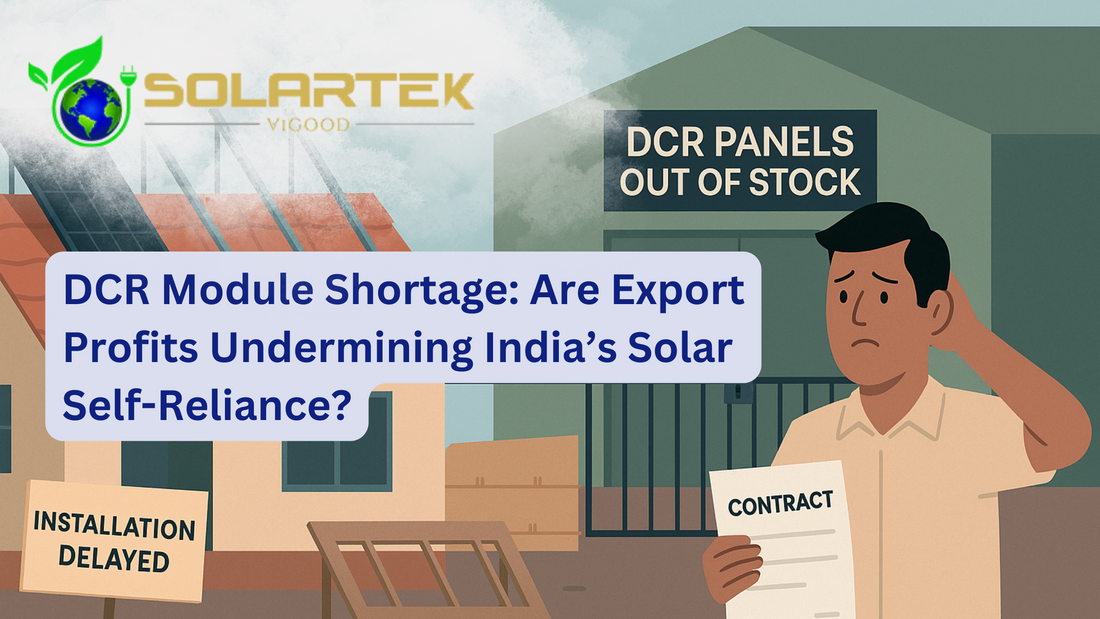
DCR Module Shortage: Are Export Profits Undermining India’s Solar Self-Reliance?
Share
India stands at the cusp of a solar revolution. With national missions like PM-KUSUM and PM Surya Ghar, and a strong push for Aatmanirbhar Bharat, the country is primed to lead in clean energy adoption. But a silent crisis is brewing—a severe shortage of DCR (Domestic Content Requirement) solar modules in the Indian market.
Why? Because nearly 80–90% of Indian solar manufacturers are prioritizing exports, especially to the United States, where profit margins are significantly higher. This export-first approach, while commercially tempting, is creating deep fissures in India's domestic solar infrastructure.
What Are DCR Modules and Why Are They Important?
DCR modules are solar panels made using locally manufactured solar cells and modules. Under Indian government schemes, especially those aimed at rural and agricultural solarization, the use of DCR modules is mandatory. These modules are a cornerstone of India’s Make in India and Aatmanirbhar Bharat initiatives.
But now, the ground reality is quite different.
The Export-Driven Profit Race:
According to a recent report by Mercom India, manufacturers are favoring exports due to:
-
25–30% profit margins in foreign markets like the U.S.
-
Low import duties in destination countries.
-
Bulk purchasing and quick payments by global clients.
In contrast, domestic buyers often offer only 10–12% margins, with longer procurement cycles and higher payment risks. As one Indian distributor bluntly put it:
“Exports give us 25–30% margins… why sell local for 10–12%?”
The Impact on India’s Solar Ambitions:
While Indian-made solar panels sail smoothly to overseas ports, back home:
-
⚠️ Solar projects are stalling due to lack of DCR modules.
-
😟 Vendors and developers face delays and cost overruns.
-
🚫 India’s solar goals under the Aatmanirbhar Bharat framework are weakening.
This situation puts small-scale developers, rooftop installers, and agricultural solar projects in a tight spot. With limited access to compliant modules, they are unable to meet deadlines or fulfill government guidelines—hurting both businesses and India’s green transition.
Policy Dilemma: Profits vs National Goals
There’s a clear conflict between free-market profits and policy-driven priorities.
✅ On one hand, we want Indian manufacturers to grow, earn, and compete globally.
🚫 On the other, we cannot ignore the fact that domestic solar infrastructure is suffering due to export bias.
So the question is: How do we strike the right balance?
Possible Solutions:
-
Incentivize Local Supply:
-
Offer tax breaks or subsidies for manufacturers who reserve a percentage of output for Indian projects.
-
-
Export Quotas:
-
Implement fair quotas or export caps during peak domestic demand seasons.
-
-
Boost DCR Procurement Platforms:
-
Improve logistics and transparency in platforms like Bharat e-Marketplace (GeM) for easier DCR procurement.
-
-
Stronger Enforcement of Domestic Schemes:
-
Ensure stricter DCR compliance under schemes like PM-KUSUM and Surya Ghar Yojana, with faster disbursal of payments.
-
-
Create Local Demand Aggregation:
-
Pool multiple smaller projects into larger procurement blocks to increase buying power for DCR modules.
-
Final Thoughts:
At Vigood Solartek, we believe in the power of sustainable, self-reliant solar energy for every Indian home, farm, and business. But for this vision to succeed, domestic supply chains must be strengthened—not sidelined.
As a nation, we must prioritize policies that support local needs without discouraging global growth. Because a truly powerful India is one that lights up its own villages before powering someone else’s grid.

